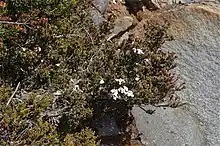| Epacris serpyllifolia | |
|---|---|
.jpg.webp) | |
| Scientific classification | |
| Kingdom: | Plantae |
| Clade: | Tracheophytes |
| Clade: | Angiosperms |
| Clade: | Eudicots |
| Clade: | Asterids |
| Order: | Ericales |
| Family: | Ericaceae |
| Genus: | Epacris |
| Species: | E. serpyllifolia |
| Binomial name | |
| Epacris serpyllifolia | |
| Synonyms[1] | |
|
Epacris serpyllifolia R.Br. var. serpyllifolia | |

Epacris serpyllifoliais a species of flowering plant in the heath family Ericaceae and is endemic to Tasmania. It is a small low-lying or weakly erect shrub with heart-shaped to broadly egg-shaped leaves and tube-shaped white flowers crowded in upper leaf axils.
Description
Epacris serpyllifolia is a prostrate, low-lying or weakly erect, sometimes bushy shrub that typically grows to a height of up to 30 cm (12 in). Its leaves are egg-shaped, 2–6 mm (0.079–0.236 in) long, sometimes with a short point on the end. The flowers are borne in leaf axils near the ends of branches with often coloured sepals about 3 mm (0.12 in) long. The petal tube is slightly longer than the sepals and the petal lobes are shorter than the petal tube, and the anthers sometimes slightly longer than the petal tube.[2][3][4]
Taxonomy
Epacris serpyllifolia was first formally described in 1810 by Robert Brown in his Prodromus Florae Novae Hollandiae.[5][6] The specific epithet (serpyllifolia) mean "wild thyme-leaved".[7]
Distribution
This epacris is endemic to Tasmania where it is widespread and abundant in alpine and subalpine areas.[8]
References
- 1 2 "Epacris serpyllifolia". Australian Plant Census. Retrieved 14 July 2022.
- ↑ Bentham, George; von Mueller, Ferdinand (1868). Flora Australiensis. Vol. 4. London: Lovell Reeve & Co. p. 240. Retrieved 14 July 2022.
- ↑ Rodway, Leonard (1903). The Tasmanian Flora. Hobart: Tasmanian Government Printer. p. 121. Retrieved 14 July 2022.
- ↑ "Epacris serpyllifolia". anpsa.org.au. Retrieved 2016-03-23.
- ↑ "Epacris serpyllifolia". APNI. Retrieved 14 July 2022.
- ↑ Brown, Robert (1810). Prodromus Florae Novae Hollandiae. London. p. 551. Retrieved 14 July 2022.
- ↑ Sharr, Francis Aubi; George, Alex (2019). Western Australian Plant Names and Their Meanings (3rd ed.). Kardinya, WA: Four Gables Press. p. 306. ISBN 9780958034180.
- ↑ Jordan, Greg. "Epacris serpyllifolia". University of Tasmania. Retrieved 14 July 2022.